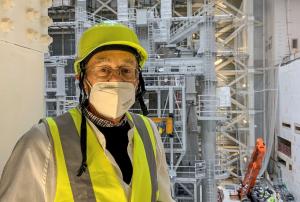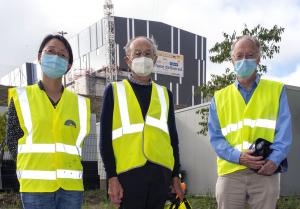Michel Huguet on the long chain of "fusion builders"
Some thirty years ago, the ITER project entered what is called the Engineering Design Activities, a phase which aimed at providing the engineering drawings and models for the construction of the planned tokamak. Work was distributed between three "Joint Work Sites": San Diego in the United States, Garching in Germany and Naka in Japan. In October 1992, Michel Huguet moved to Naka to head the Joint Work Site there. Having joined the French fusion program as early as 1969, later to spend over 12 years at JET during construction and early operation, he was one of the most respected authorities in the field. When he retired from the Naka Joint Work Site in 2003, he was hailed as someone "who played a crucial role in establishing the convincing scientific and technical basis for ITER implementation." On a visit to the ITER site last week, he sat with Newsline and reflected on ITER, and the past and future of fusion energy.
Does the ITER you saw on your visit correspond to the images of ITER you formed, close to 30 years ago, at the start of the Engineering Design Activities when you headed the ITER Joint Work Site in Naka? In what way is it similar or different technically, and also visually and emotionally?
Since the start of ITER Engineering Design Activities (EDA) in 1992, the design of the ITER tokamak has evolved significantly. There was an evolution from the initial design concepts as envisioned by Paul-Henri Rebut, the first ITER Director, to the engineering design under the leadership of Robert Aymar, the second ITER Director. In 1998, as a consequence of the decision of the USA to withdraw from the ITER EDA, the machine size was reduced and the scientific objectives were revised in order to achieve a significant cost reduction. The final EDA design established between 1998 and 2001 is very close to the current ITER design.
The design of the machine components is therefore very familiar to me and I have kept in touch as I have been involved in ITER technical reviews from the start of the construction phase. Nevertheless, I find the sheer size of these components extremely impressive. To me, being able to see the vacuum vessel sectors, the magnet coils, and the sector sub-assembly tool in operation has been a wonderful and rewarding experience.
As an engineer, I wish to express my appreciation for the work accomplished so far by the ITER Organization and the Domestic Agencies.
Your career in fusion began in the late 1960s. How did you picture the future of fusion at that time? Did you expect that it would take more than sixty years to have a machine that would aim for net energy production and demonstrate the feasibility of fusion?
I was lucky to start working in the field of fusion in 1969 at a very exciting time. This was when the Russian T3 tokamak results were confirmed by a United Kingdom team headed by Derek Robinson. All fusion laboratories worldwide started building tokamaks. In Fontenay-aux-Roses, I was given the responsibility for the magnet system of TFR—the first French tokamak. At that time, fusion research was in its infancy and nobody had a clear understanding of the challenges ahead toward fusion power generation. It is only in 1982 that H-mode operation was discovered in ASDEX by Fritz Wagner and his team. Personally, the experience gained during design, construction and operation of JET¹ made me well aware that fusion was a new paradigm in research because of the unprecedented timescale necessary for development. Just like the medieval cathedral builders, physicists and engineers form a multi-generation chain of fusion builders.
In your opinion, what are the major challenges that stand in the way of industrial and commercial fusion?
There are still physics and technology challenges. Power exhaust in the divertor is a typical example of a challenge to be addressed in ITER which requires a coordinated physics and technology approach. Beyond ITER, DEMO must address the blanket design, material issues including radiation damage, and reliability and availability under the constraints of remote maintenance. Ultimately, the price of fusion electricity must be affordable.
Fusion development also faces other, non-technical challenges. Fusion requires long-term political vision and resolve and a rational approach to energy and environmental issues. Importantly, it also must gain and maintain public acceptance. These challenges are an essential part of the development program that have to be addressed actively.
All these technical and non-technical challenges are formidable but the promises of fusion energy as a safe, steady state and virtually unlimited source of energy give confidence in the determination to face them.
How do you view the recent emergence of fusion start-ups claiming that they can build smaller reactors, faster and cheaper than ITER?
Recently, the triumphant claims from these start-ups have been related to high field magnet development using new high temperature superconductors (HTS). High field magnets require thick and heavy structures and it remains to be seen how much they can improve fusion performance once manufacturing and structural issues, including fatigue issues due to cyclic loads, have been fully analyzed. Apart from magnet and structural aspects, the issues posed by power exhaust in the divertor and by the blanket design do not seem to have been addressed, although they are expected to be more severe in high field compact tokamaks than in ITER.
In my opinion, small-or medium-size high field tokamaks may achieve plasma experiments with high Q values but, unlike ITER, they are not a viable path toward power reactors.
You were involved in the construction of JET. Based on that experience, what advice or recommendation would you give to those who are building ITER today?
From what I have seen during my visit and from the numerous design reviews that I have headed, I believe that ITER activities are carried out with a high level of professionalism.
The advice I could propose is to never cut corners on quality requirements, keeping in mind that whatever has not been fully inspected is likely to be inadequate in some respect.
Access for repair becomes increasingly awkward, and may possibly become impossible, as assembly progresses. One day spent in repairing a component when still fully accessible may save weeks or months of delay compared to when that component has been integrated into the machine.
Likewise, assembly activities should be carried out as much as possible during the preparation of components or sub-assemblies before their transfer to their final location where access will be difficult and risks interfering with other activities.
¹ In September 1973, Michel Huguet joined the JET design team at Culham (UK) as group leader, Toroidal Field Magnet and Mechanical Structure. In June 1978, at the start of the JET construction phase, he was appointed head of the Magnet Division. Having also headed the Torus Division and the Machine and Development Department, he was appointed JET Associate Director in 1988. During this period he was involved in all machine upgrades and aspects of operation including the tritium experiment in November 1991.



